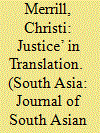| Srl | Item |
| 1 |
ID:
105179


|
|
|
|
|
| Publication |
2011.
|
| Summary/Abstract |
In September 2009, the Information Office of the State Council of the People's Republic of China claimed that Xinjiang benefits from respect and harmony between the ethnic groups. This rhetoric is faithfully propagated by national media: they uniformly praise the unity amongst the Han and Uyghurs through the common slogans of minzu tuanjie (ethnic unity ) and hexie guanxi (harmonious relations). Going beyond the official documents and propaganda, my purpose is to explore the relations between these two ethnic groups. I will focus on the ideas, words and actions of Han and Uyghur young people living in Urumqi who are often under-represented in official sources, or other forms of written and scholarly discourse. While comparing their behaviour, I argue that ethnic disharmony between Hans and Uyghurs exists, but it is simplistic to blame only the Chinese government or one of the ethnic groups, and naïve to ask what China can do to solve the problem. Instead, by exploring what the social agents in the young educated society in Xinjiang truly think of ethnic relations between them and the "other," this paper presents a comprehensive picture of the issue. My ethnographic research interprets how people remember, interpret and sometimes exaggerate their ethnic traditions and cultural practices in daily life in relation to the other ethnic group. The findings demonstrate how young people are determining the course of ethnic relations by constructing movable social barriers that result in segregation between them, raising doubts about the future possibilities for ethnic harmony.
|
|
|
|
|
|
|
|
|
|
|
|
|
|
|
|
| 2 |
ID:
175489


|
|
|
|
|
| Summary/Abstract |
The story of Kausalya Baisantry’s life of anti-caste activism is featured in Urmila Pawar and Meenakshi Moon’s Amhihi Itihasa Ghadavala (We Also Made History) in Marathi, and in her own book-length work of ‘autobiography literature’ written in Hindi as Dohra Abhishap (Doubly Cursed), but it is a speech Baisantry delivered in English as a college student activist that Pawar and Moon discuss as an example of ‘Sahityatun Prabodhan (Enlightenment through Literature)’. I trace connections between Pawar and Baisantry to show how multilingual these activist networks of ‘Sahityatun Prabodhan’ are, focusing specifically on Baisantry’s translation from Marathi of Pawar’s short story ‘Nyay (Justice)’, published in the leading Hindi literary journal Hans in 1991.
|
|
|
|
|
|
|
|
|
|
|
|
|
|
|
|